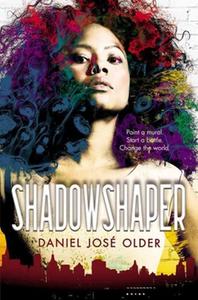
Daniel José Older has published a collection of stories, Salsa Nocturna, and co-edited an anthology of speculative fiction titled Long Hidden. His first adult novel, Half-Resurrection Blues, was published by Roc earlier this year. In his first book for young adults, Shadowshaper (Arthur A. Levine Books, June 30, 2015), Older brings ancestral spirits and shadowshapers to modern Brooklyn, and introduces Sierra, a realistic young heroine who uses her artistic talent to protect the living and the dead.
You've written a book in which many teens will recognize themselves, perhaps for the first time, and others will learn about an urban culture they may not have encountered before. But more than anything, you've given readers a rip-roaring good story. Can you tell us how you combined thriller pacing and a vivid cultural setting so successfully?
Thank you! That means a lot because that is exactly what I set out to do. We have this idea that something can either be an "issues" book or an adventure. I reject the premise. Great stories are made up of messy, complicated power dynamics and challenging times. Tackling difficult issues requires vivid storytelling.
From a craft point of view, I've found that looking at context as a source of conflict and crisis not only enhances the plot by raising tension, but also allows room to talk about those nitty-gritty intersections of oppression and resistance. I write about cities, and the American city is in crisis, so this is also a question of telling the truth.
 Sierra is such a vivid and strong teenager. What was your inspiration?
Sierra is such a vivid and strong teenager. What was your inspiration?
I'm blessed to be surrounded by many amazing women that I have always looked to for inspiration: my amazing wife, my mom, sister, some of my closest friends, my mentors Tananarive Due and Sheree Renée Thomas, and the young women I've taught over the years. Beyond that, I think it's important to be very intentional about reading non-male writers, and most of all, it's important to listen, truly listen.
Is the magic in this book--the shadowshapers, corpuscules and throng haints--borrowed from a particular tradition or did you make it up?
The word haint comes from a Southern black tradition. I added throng to the front of it because these particular creatures are a mashed-together jumble of captured spirits. I made up corpuscules; they're a kind of modified zombie with somebody else's soul stuffed into it. Both are ways of thinking about captivity, consent and free will. These are the actual bodies and souls of people being used to do things they would've never done in life. So when Sierra has to confront them, she's often up against familiar faces, which is an added challenge and speaks to the complicated way power functions in community.
Shadowshaping is something I came up with along the journey of writing the book. Originally, there were a lot more monsters and different collectives of creatures around the city, one of which was called the Painted Dead. Somewhere along the way, the Painted Dead became central to the story and so Sierra needed a magic that would speak to that.
Murals, and memorial murals in particular, have always struck me as a very alive, awesome kind of art--they're not in museums, they're right there in everyday life and they can catch you off guard; that glory will sneak up on you. I love that. There is resistance in the act of remembering, especially in these times of what Eduardo Galeano called "obligatory amnesia." In the landscape of changing neighborhoods and forced displacement, a painted face on a wall can be a very palpable act of resistance. I also love the idea of art literally coming to life and doing things, taking action, because in a symbolic kind of way, it does exactly that: it changes the world. At some point in writing this book, I realized that ghost stories aren't about death at all--they're about life. --Angela Carstensen, school librarian and blogger

